
Hermit crabs are anomuran decapod crustaceans of the superfamily Paguroidea that have adapted to occupy empty scavenged mollusc shells to protect their fragile exoskeletons. There are over 800 species of hermit crab, most of which possess an asymmetric abdomen concealed by a snug-fitting shell. Hermit crabs' soft (non-calcified) abdominal exoskeleton means they must occupy shelter produced by other organisms or risk being defenseless.

Oedignathus inermis is a species of king crab found off the Pacific coasts of the United States and Canada, from California to Alaska, and disjunctly around the coasts of Japan. It is the only species in the genus Oedignathus, and is sometimes called the granular claw crab, paxillose crab, or tuberculate nestling lithode crab.
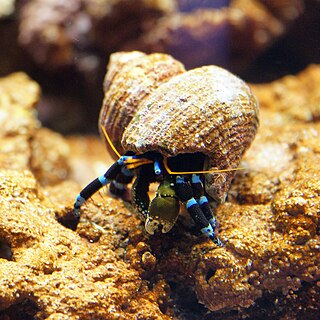
Calcinus is a genus of hermit crabs in the family Diogenidae, containing the following species:

Calcinus elegans, also known as the blue line hermit crab, is a small, tropical hermit crab.

Dardanus pedunculatus, commonly referred to as the anemone hermit crab, is a species of hermit crab from the Indo-Pacific region. It lives at depths of up to 27 m and collects sea anemones to place on its shell for defence.
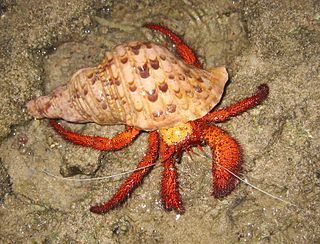
Dardanus megistos, the white-spotted hermit crab or spotted hermit crab, is a species of hermit crab belonging to the family Diogenidae.
Calcinus tubularis is a species of hermit crab. It is found in the Mediterranean Sea and around islands in the Atlantic Ocean, where it lives below the intertidal zone. Its carapace, eyestalks and claws are marked with numerous red spots. C. tubularis and its sister species, C. verrilli, are the only hermit crabs known to show sexual dimorphism in shell choice, with males using normal marine gastropod shells, while females use shells of gastropods in the family Vermetidae, which are attached to rocks or other hard substrates.
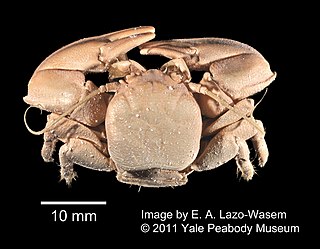
Petrolisthes eriomerus is a species of marine porcelain crab found in the eastern Pacific Ocean. It is commonly known as the flattop crab. It is a flattened, rounded animal, with a carapace up to 20 mm (0.8 in) across. It is a filter feeder, and also sweeps food from rocks.

Lybia tessellata is a species of small crab in the family Xanthidae. It is found in shallow parts of the tropical Indo-Pacific Ocean. Like other members of the genus Lybia, it is commonly known as the pom-pom crab,cheerleader crab, or boxer crab because of its habit of carrying a sea anemone around in each of its claws, these resembling pom-poms or boxing gloves.

The thinstripe hermit crab, Clibanarius vittatus, is a species of hermit crab in the family Diogenidae. It is found in the Caribbean Sea, the Gulf of Mexico and the western Atlantic Ocean.
Lauridromia intermedia is a species of crab in the family Dromiidae and is native to the western Indo-Pacific. It often carries a piece of sponge on its back by way of camouflage, and one individual was found carrying a sea anemone in a similar manner.

Alpheus fasqueli is a crustacean belonging to the family of snapping shrimp. It was first isolated in Sri Lanka. It counts with a setose carapace, an acute and carinate rostrum, and unarmed orbital hoods. Its basicerite has a strong ventrolateral tooth. The lamella of its scaphocerite is not reduced. Its third maxilliped counts with an epipodial plate bearing thick setae, while its first chelipeds are found with their merus bearing a strong disto-mesial tooth; its third pereiopod has an armed ischium, with a simple and conical dactylus. Its telson is broad, distally tapering, with 2 pairs of dorsal spines. The species is named after Frédéric Fasquel, a photographer who contributed rare shrimp specimens for the Muséum national d'histoire naturelle.
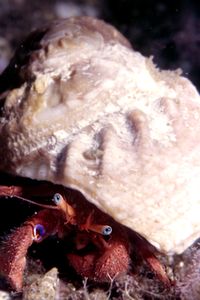
Paguristes eremita, the eye spot hermit crab, is a species of hermit crab in the family Diogenidae. It is found in the Mediterranean Sea.

Calcinus laevimanus is a species of hermit crab in the genus Calcinus found in the Indo-West Pacific region, the type locality being Hawaii.

Heteromysis is a genus of marine mysid crustaceans from the family Mysidae, associated with various shallow-water invertebrates. The name describes differentiation of its pereiopods as possible adaptation to commensal life-style. Heteromysis is one of the largest mysid genera, containing more than 100 species. The genus is distributed globally, but predominantly in tropical and subtropical waters.
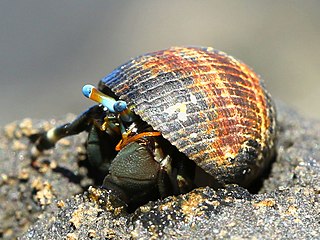
Calcinus seurati, commonly known as Seurat's hermit crab or whitebanded hermit, is a species of hermit crab in the family Diogenidae. It was first described by French carcinologist Jacques Forest in 1951.

Paguristes puncticeps is a hermit crab, in the family Diogenidae. It is found in shallow waters in the tropical western Atlantic Ocean, the Caribbean Sea and the Gulf of Mexico. Like other hermit crabs, it lives inside an empty mollusc shell, which it changes periodically as it grows.
Calcinus argus, also known as the Argus hermit crab, is a species of hermit crabs in the family Calcinidae described by David Wooster in 1984. Originating from the Indo-West Pacific near Hawaii.

Calcinus laurentae is a species of left-handed hermit crab in the family Diogenidae. The common name for Calcinus laurentae is Laurent's Hermit Crab or Redleg calcinus. Calcinus laurentae are native to Hawaii and the Hawaiian word for hermit crab is unauna.
Calcinus revi, commonly known as the white hermit crab, is a species of hermit crabs in the family Calcinidae.















